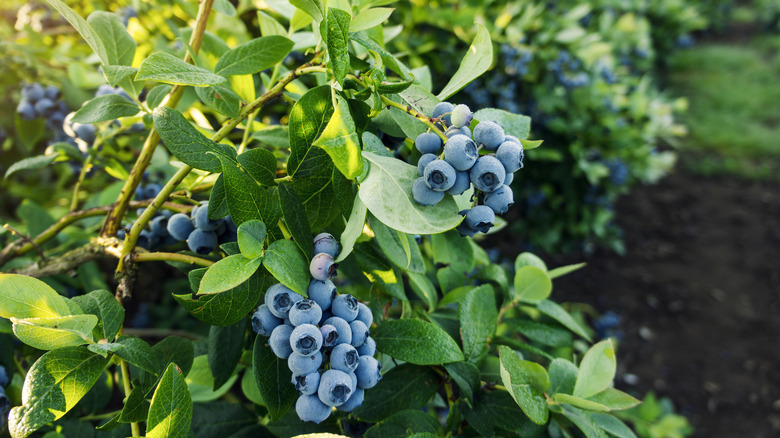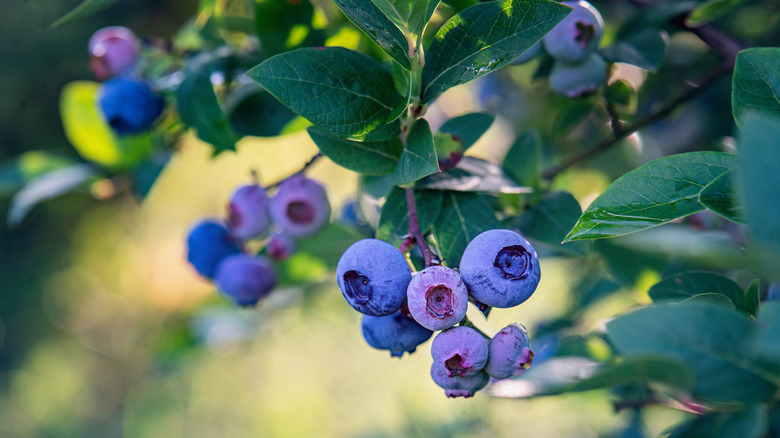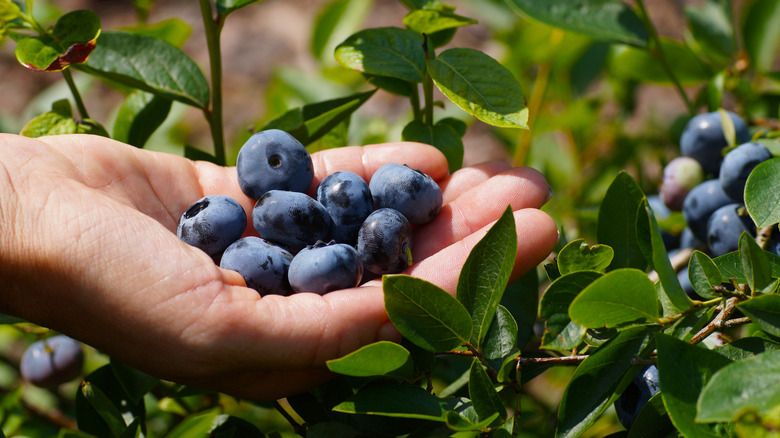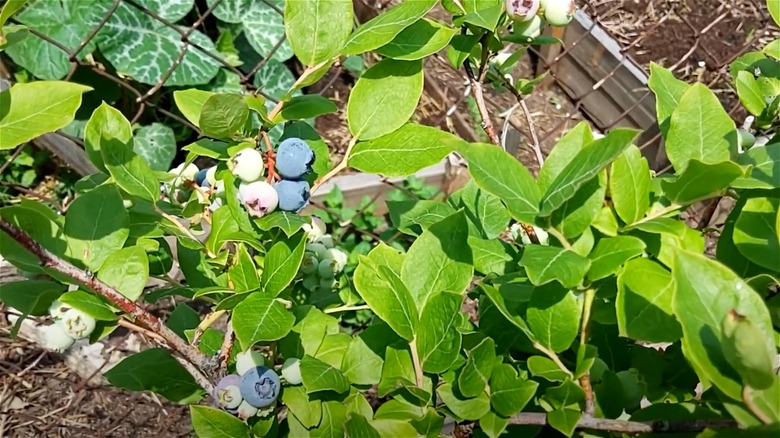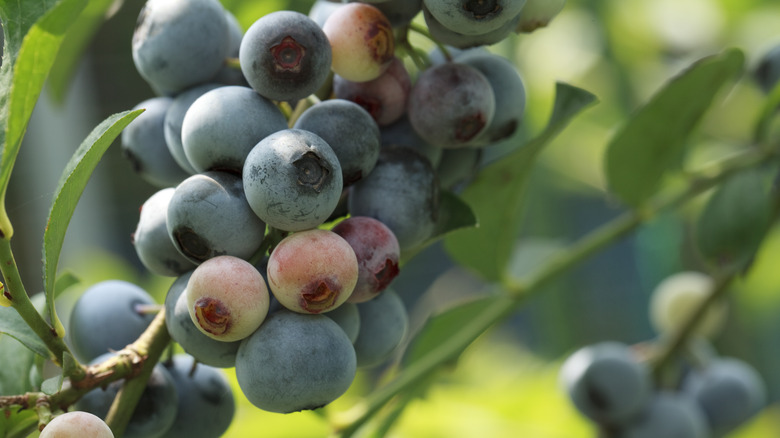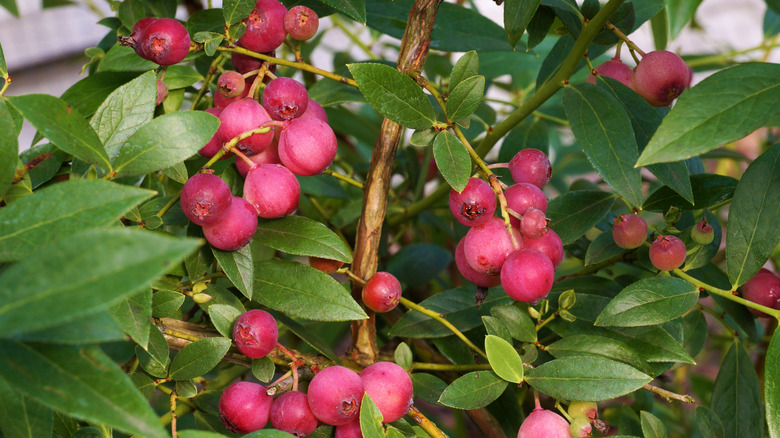Delicious Varieties Of Blueberries That Will Thrive In Your Garden
Most people have a designated goal in mind when designing their landscaping or garden space. Some invest in flowering trees and garden beds to boost their home's curb appeal, making it more pleasant to look at from the street. Others might want to attract pollinators like butterflies and bees to their yard, while still others may desire to grow certain plants to cut down on their grocery bills. If you want to experience all of these benefits — an aesthetic boost, more pollinators, and edible produce — by just adding one plant, consider including a blueberry bush on your property.
Not only do gorgeous blueberry bush flowers provide plenty of food for important pollinators while the berries provide food for us, but these plants are also relatively easy to grow. They don't require pesticides to survive, don't need overly-fertile soil to thrive, and some are self-pollinating. Even better, there are a ton of different varieties and cultivars you can try experimenting with, allowing you to choose one that best fits your needs and wants. Here are five popular types to consider planting in your yard.
Best for baking purposes: 'Bluecrop' blueberry plant
If you're looking for a blueberry plant that will yield great harvests for baking, jam-making, and freezing, then the Highbush 'Bluecrop' plant (Vaccinium corymbosum 'Bluecrop') may be your ideal choice. The berries from this bush are juicy and just a bit tart, so they're perfect for all your baking needs, whether that's for muffins or pancakes. You will also get quite the yield, as this particular cultivar is ready to be picked in July and can produce up to 20 pounds per bush, meaning you will have delicious fruit all season long. It's also a great type to choose if you love birds since it attracts eastern bluebirds, mourning doves, and northern cardinals.
You can plant this variety if you live in USDA hardiness zones 4 to 7. It loves to be in full sun and loamy soil that has a pH level between 4.5 and 5.5. It will grow to be a maximum of 6 feet tall and 4 feet wide, and it's self-pollinating, so you don't have to worry about planting other blueberry plants nearby. However, doing so will get you more fruit each season. If you choose to grow a pollinating partner, your best options are either the Earliblue or Jersey blueberry variety.
Best for large berries: 'Chandler' blueberry plant
If you're looking for a blueberry plant that will provide large, juicy berries, look no further than the Highbush 'Chandler' bush (Vaccinium corymbosum 'Chandler'). This creates some of the biggest berries you can grow, making them perfect for a quick snack or a fresh addition to your breakfast or a sweet dessert dish. These plants bear fruit for four to six weeks, so you will have plenty of time to get your fill. They can also be a nice addition to your landscaping design since the bushes can grow to a height of 6 feet.
Just like with the 'Bluecrop' blueberry plant, this particular variety is best planted in hardiness zones 4 to 7. It likes full sun, loamy soil, and dirt with a pH level between 4.5 to 5.5. If you meet all of those conditions, it will take about one year for the first berries to bloom, and they will drop around July. Once they do, you will have sweet, extra-large berries to eat by the handful. This is also a great pick for beginner gardeners because it's self-pollinating, so you don't have to stress about attracting bees to your garden or planting another blueberry bush for cross-pollination purposes.
Best for colder regions: 'Northland' blueberry plant
If you're mostly concerned about weather when choosing your variety because you live in a cold climate, don't make the mistake when growing blueberry bushes of choosing the wrong type. Instead, decide upon a winter-hardy option like the Northern Highbush 'Northland' blueberry plant (Vaccinium corymbosum 'Northland'). This plant can drop fruit even after experiencing winters with temps of -30 degrees Fahrenheit. This means you will have fresh fruits come spring no matter how bitter the frost becomes. Its branches are also a little more elastic than other varieties, which is great for northern areas since they won't snap under the weight of snow.
This variety is best grown in hardiness zones 3 to 7 and prefers to be planted in soil with a pH of 4.5 to 4.8. It prefers full sun but will also thrive in partial shade. If all of these needs are met, it will take between two to three years to drop berries. It's a mid-season bloomer and is also one of the heaviest-producing varieties, so you will get tons of berries around this time. Expect to get around 20 pounds from a single season.
Best for warmer regions: Rabbiteye blueberry plant
If you're looking to cultivate blueberries in a warmer region, then you can't go wrong with the Rabbiteye variety (Vaccinium virgatum/ashei). It grows wild in hot and humid states like Florida, Georgia, and Alabama, so you know it can stand up to high temperatures. It's also a drought-resistant plant thanks to its shallow roots, so you don't have to fret if you get dry spells. There are various types of rabbiteye, allowing you to get even more specific depending on your needs. For example, the 'Baldwin' type blooms mid- to late-season, whereas 'Brightwell' ripens in early- to mid-season.
This variety likes soil with pH that's between 4.5 and 5.8, and the more acidic, the better. They love full sun but can thrive in partial shade, and they're great for beginner gardeners because they can grow in dirt that isn't extra-nutritious. However, these aren't self-pollinating and will need to be cross-pollinated in order to flower. In addition, they have their own special pollinators — you can't depend on honeybees to pollinate them, as they're not very efficient. Instead, you will need either the carpenter or blueberry bee to make trips to your yard.
Best for ornamental purposes: 'Pink Lemonade' blueberry plant
Are you looking for a blueberry bush that will not only provide ripe berries but will also add something to your curb appeal? If so, try your hand at planting the Rabbiteye 'Pink Lemonade' blueberry bush (Vaccinium 'Pink Lemonade'). It will bloom with pink flowers in the spring, which will eventually transform into pink blueberries. You read that right — pink! But the plant doesn't stop adding value after all the berries have been picked. In autumn, its green leaves will change to a head-turning orangish color, adding variety to your landscaping.
The fruit also has a slight citrusy taste, making this plant an exciting addition to your home garden. Thriving in hardiness zones 4 to 8 and enjoying a soil pH level between 4.5 to 5.5, they also like full sun and consistently-moist soil. These bushes will grow a maximum of 5 feet tall and 5 feet wide. It can take two to three years before they begin producing fruit in the summertime. The bushes are also self-pollinating, so you won't have to worry about planting similar varieties nearby. However, doing so can increase your fruit yield, so it's worth trying.
